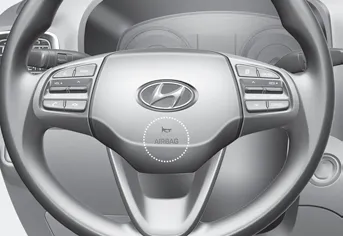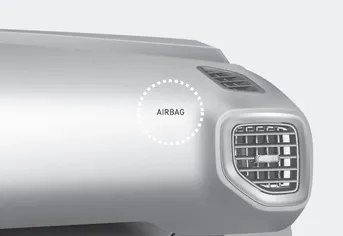Hyundai Venue (QX): Air Bag - Advanced Supplemental Restraint System / Where Are the Air Bags?
DriverŌĆÖs and passengerŌĆÖs front air bags
Your vehicle is equipped with an Advanced Supplemental Restraint System (SRS) and lap/shoulder belts at both the driver and passenger seating positions.
The SRS consists of air bags which are located in the center of the steering wheel, in the driverŌĆÖs side lower crash pad below the steering wheel column and the passengerŌĆÖs side front panel pad above the glove box.
The air bags are labeled with the letters ŌĆ£AIR BAGŌĆØ embossed on the pad covers.

DriverŌĆÖs front air bag

PassengerŌĆÖs front air bag
The purpose of the SRS is to provide the vehicleŌĆÖs driver and front passengers with additional protection than that offered by the seat belt system alone.
The advanced SRS offers the ability to control the air bag inflation within two levels. A first stage level is provided for moderate-severity impacts. A second stage level is provided for more severe impacts.
According to the impact severity, the SRS Control Module (SRSCM) controls the air bag inflation. Failure to properly wear seat belts can increase the risk or severity of injury in an accident.
WARNING
To reduce the risk of serious injury or death from inflating front air bags, take the following precautions:
- Seat belts must be worn at all times to help keep occupants positioned properly.
- Move your seat as far back as possible from front air bags, while still maintaining control of the vehicle.
- Never lean against the door or center console.
- Do not allow the front passenger to place their feet or legs on the dashboard.
- No objects (such as crash pad cover, cellular phone holder, cup holder, perfume or stickers) should be placed over or near the air bag modules on the steering wheel, instrument panel, windshield glass, and the front passengerŌĆÖs panel above the glove box. Such objects could cause harm if the vehicle is in a crash severe enough to cause the air bags to deploy.
1. DriverŌĆÖs front air bag 2. PassengerŌĆÖs front air bag 3. Side air bag 4. Curtain air bag This vehicle is equipped with an Advanced Supplemental Air Bag System for the driverŌĆÖs seat and front passengerŌĆÖs seats.
Your vehicle is equipped with a side air bag in each front seat. The purpose of the air bag is to provide the vehicleŌĆÖs driver and the front passenger with additional protection than that offered by the seat belt alone.
Other information:
Hyundai Venue (QX) (2020-2025) Service Manual: General safety information and caution
Instructions (R-134a) When Handling Refrigerant 1. R-134a liquid refrigerant is highly volatile. A drop on the skin of your hand could result in localized frostbite. When handling the refrigerant, be sure to wear gloves.
Hyundai Venue (QX) (2020-2025) Service Manual: Compressor. Description and operation
Description The compressor is the power unit of the A/C system. It is located on the side of engine block and driven by a V-belt of the engine. The compressor changes low pressure and low temperature refrigerant gas into high pressure and high temperature refrigerant gas.
Categories
- Manuals Home
- Hyundai Venue Owners Manual
- Hyundai Venue Service Manual
- Components and components location
- Instrument Cluster
- Maintenance
- New on site
- Most important about car
